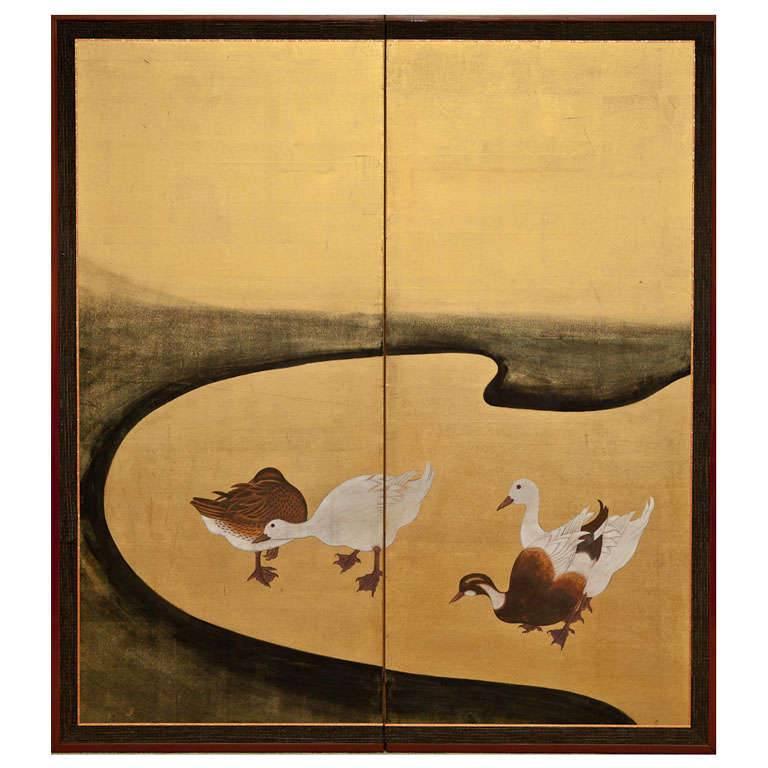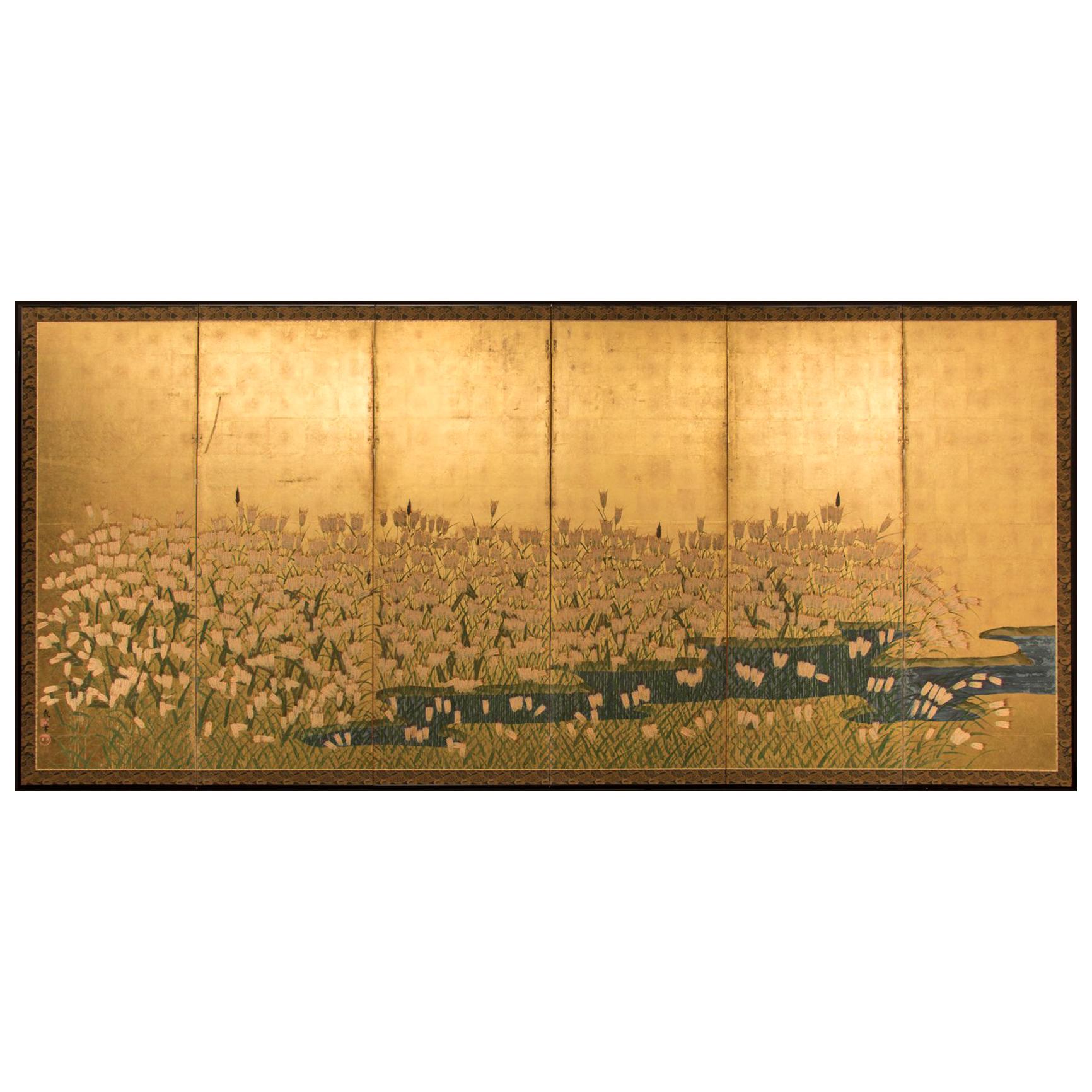Items Similar to Japanese Two Panel Screen: Flowers by River's Edge
Want more images or videos?
Request additional images or videos from the seller
1 of 16
Japanese Two Panel Screen: Flowers by River's Edge
About the Item
Mineral pigments on gilded silk with gilded bronze hardware. Signature reads: Shunkan.
- Dimensions:Height: 68.63 in (174.33 cm)Width: 68.63 in (174.33 cm)Depth: 0.75 in (1.91 cm)
- Materials and Techniques:
- Place of Origin:
- Period:
- Date of Manufacture:circa 1930
- Condition:Condition Report Upon Request.
- Seller Location:Hudson, NY
- Reference Number:
About the Seller
5.0
Recognized Seller
These prestigious sellers are industry leaders and represent the highest echelon for item quality and design.
Established in 1971
1stDibs seller since 2008
153 sales on 1stDibs
Typical response time: 16 hours
Associations
The Art and Antique Dealers League of AmericaAntiques Associations Members
- ShippingRetrieving quote...Ships From: Hudson, NY
- Return PolicyThis item cannot be returned.
More From This SellerView All
- Japanese Two Panel Screen: Flowers by River's EdgeLocated in Hudson, NYMineral pigments on gilded silk with gilded bronze hardware. Signature reads: Shunkan.Category
Vintage 1930s Japanese Paintings and Screens
MaterialsBronze
- Japanese Two Panel Screen: Water Fowl by River's EdgeLocated in Hudson, NYJapanese Two Panel Screen: Water Fowl by River's Edge, Showa period (1926 - 1989) painting of fowl on a river bank. Very art deco in style. Painted in mineral pigments on gold pape...Category
Early 20th Century Japanese Showa Paintings and Screens
MaterialsSilk, Wood, Paper
- Japanese Six Panel Screen Field of Wheat by River's EdgeLocated in Hudson, NYMineral pigments on gold leaf, signature and seal read: Kenzan.Category
Antique 19th Century Japanese Paintings and Screens
MaterialsGold Leaf
- Japanese Two-Panel Screen Spring FlowersLocated in Hudson, NYA vibrant celebration of spring using a colorful ensemble of coxcomb, irises, lilies, hybiscus, and a blossoming cherry tree. Great examples of "tarashikomi" or "painting-in", a Rim...Category
Vintage 1930s Japanese Showa Paintings and Screens
MaterialsSilk, Paper
- Japanese Two Panel Screen: Summer FlowersLocated in Hudson, NYScreen depicts Summer flowers and birds on gilded silk. Signature reads: Konishi Fukunen. Notes about Artist: Konishi Fukunen (1887-1959) was born the second son of the Paper mounting specialist Konishi Uhei in Takeo, Fukui prefecture in the mid Meiji period. In 1902 he was sent to Kyoto to study painting under Suzuki Shonen...Category
Mid-20th Century Japanese Paintings and Screens
MaterialsSilk
- Japanese Six-Panel Screen "Wild Grasses and Peonies by Rivers Edge"Located in Hudson, NYJapanese Six Panel Screen: Wild Grasses and Peonies by Rivers Edge. Early Meiji period (1868 - 1912) painting of a grassy knoll next to a running brook or river. A soft breeze is m...Category
Antique 1880s Japanese Meiji Paintings and Screens
MaterialsGold Leaf
You May Also Like
- Japanese Edo Two-Panel Screen Flowers of AutumnLocated in Rio Vista, CAImpressive early 19th century Japanese Edo period two-panel screen featuring flowering plants and grasses of autumn. Painted in the Tosa School style Bunka Bunsei period or Ogosho pe...Category
Antique 19th Century Japanese Edo Paintings and Screens
MaterialsSilk, Wood, Paper
- Japanese Two-Panel Gold Leaf Screen by YoshikawaLocated in Rio Vista, CAStunning Japanese two-panel folding screen featuring a gold leaf landscape signed by Yoshikawa. Delicate scene of cherry and willow trees near a village with high mountains in the ba...Category
20th Century Chinese Meiji Paintings and Screens
MaterialsBrass, Gold Leaf
- Japanese Edo Two Panel Screen Deities by Yokoyama KazanLocated in Rio Vista, CAWhimsical Japanese late Edo period two-panel screen circa 1800 by Yokoyama Kazan (Japanese 1784-1837). The screen depicts four of the seven Gods or deities ...Category
Antique 19th Century Japanese Edo Paintings and Screens
MaterialsBrass, Gold Leaf
- Japanese Meiji Two Panel Screen Geese and ReedsLocated in Rio Vista, CAFantastic Japanese late Meiji period two-panel byobu screen by Hashimoto Koshu. The large screen features two white geese amid brightly colored reeds. The symbolism of geese and reeds was introduced to Japan from China in the 13th century. This was a popular subject for Japanese zen artists of the period. Beautifully crafted with exceptional brush strokes and details. Made with natural pigments in dramatic vivid colors of white, pink, and mint green on a silk background of gilt. Circa 1900 with artist seal on bottom right corner. Koshu studied Western art under...Category
20th Century Japanese Meiji Paintings and Screens
MaterialsSilk, Wood, Paper
- Japanese Showa Two Panel Screen Blossoming Prunus TreeLocated in Rio Vista, CASerene Japanese Showa period two-panel folding byobu screen depicting a large spring blossoming prunus tree or plum tree. Beautifully painted with ink and natural color pigments on m...Category
20th Century Japanese Showa Paintings and Screens
MaterialsBrass
- Japanese Taisho Two Panel Screen Heian Period Flute PlayerLocated in Rio Vista, CAExtraordinary Japanese Taisho period two panel byobu screen depicting Fujiwara Yasumasa playing the flute in the Ichihara Moor. Fujiwara Yasumasa (958 to 1036) was a famous Heian period...Category
20th Century Japanese Taisho Paintings and Screens
MaterialsWood, Paper, Silk
Recently Viewed
View AllMore Ways To Browse
Bronze Hardware
1930 Japan
Gold Japanese Flowers
Asian Silk Screen Art
Gold Japanese Panel
Vintage Japanese Screen
Japanese Screen Two
Japanese Silk Screens
Japanese Silk Screen Art
Japanese Panel Art Screen
Japanese Panel Screens
Bronze Screens
Two Panel Screen
Gold Japanese Screens
Gold Screen Japan
Silk Screen Japan
Japanese Silk Screen Painting
Japanese Gold Screen





